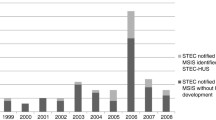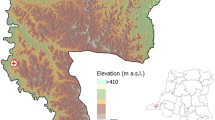Abstract
Haemolytic-uraemic syndrome (HUS) is a rare disease mainly affecting children that develops as a complication of shiga toxin-producing Escherichia coli (STEC) infection. It is characterised by acute kidney injury, platelet consumption and mechanical destruction of red blood cells (haemolysis). In order to test the working hypothesis that the spread of the infection is influenced by specific climatic conditions, we analysed all of the identified cases of infection occurring between June 2010 and December 2013 in four provinces of Lombardy, Italy (Milano, Monza Brianza, Varese and Brescia), in which a STEC surveillance system has been developed as part of a preventive programme. In the selected provinces, we recorded in few days a great number of cases and clusters which are unrelated for spatially distant or for the disease are caused by different STEC serotypes. In order to investigate a common factor that favoured the onset of infection, we have analysed in detail the weather conditions of the areas. The daily series of temperature, rain and relative humidity were studied to show the common climate peculiarities whilst the correlation coefficient and the principal component analysis (PCA) were used to point out the meteorological variable, maximum temperature, as the principal climate element in the onset of the infection. The use of distributed lag non-linear models (DLNM) and the climate indices characterising heat waves (HWs) has allowed to identify the weather conditions associated with STEC infection. The study highlighted a close temporal correlation between STEC infection in children and the number, duration and frequency of heat waves. In particular, if the maximum temperature is greater than 90th percentile, days classified as very hot, for 3 or more consecutive days, the risk of infection is increasing.





Similar content being viewed by others
References
Acquaotta F, Fratianni S (2013) Analysis on long precipitation series in piedmont (North-West Italy). Am J Clim Chang 2:25–33. doi:10.4236/ajcc.2013.21003
Acquaotta F, Fratianni S, Cassardo C, Cremonini R (2009) On the continuity and climatic variability of the meteorological stations in Torino, Asti, Vercelli and Oropa. Meteorog Atmos Phys 103:279–287. doi:10.1007/s00703-008-0333-4
Acquaotta F, Fratianni S, Garzena D (2015) Temperature changes in the North-Western Italian Alps from 1961 to 2010. Theor Appl Climatol 122:619–634. doi:10.1007/s00704-014-1316-7
Aguilar E, Inge Auer I, Brunet M, Peterson TC, Wieringa J (2003) Guidelines on climate metadata and homogenization. World Meteorological Organization WMO/TD No. 1186
Akaike H (1973) Information theory and an extension of the maximum likelihood principle, in: B.N. Petrov and F. Csaki, eds., 2nd lnternat. Syrup. on Information Theory (Akademia Kiado, Budapest), 267–281
Ardissino G, Daccò V, Paglialonga F, Testa S, Loi S, Edefonti A, Cusi D, Sereni F (2003) Weather and hemolytic uremic syndrome. Pediatr Nephrol 18:1195–1196. doi:10.1007/s00467-003-1247-5
Ardissino G, Possenti I, Salardi S, Tel F, Colombo E, Testa S, Daprai L, Picicco D, Colombo RM, Torresani E (2014) Co-infection in children with bloody diarrhea caused by shiga toxin–producing Escherichia coli: data of the North Italian HUS network. Journal of Pediatric Gastroenterology & Nutrition 59:218–220
Ardissino G, Salardi S, Colombo E, Testa S, Borsa-Ghirardelli N, Paglialonga F, Paracchini V, Tel F, Possenti I, Berlingheri M, Civitillo CF, Sardini S, Ceruti S, Baldioli C, Tommasi P, Parola L, Russo F, Tedeschi S (2016) Epidemiology of haemolytic uremic syndrome in children. Data from the North Italian HUS network. Eur J Pediatr 175:465–473. doi:10.1007/s00431-015-2642-1
Bai L, Ding G, Gu S, Bi P, Su B, Qin D, Xu G, Liu Q (2014) The effects of summer temperatures and heat waves on heat-related illness in a coastal city of China, 2011–2013. Environ Res 132:212–219
Caprioli A, Morabito S, Brugère H, Oswald E (2005) Enterohaemorrhagic Escherichia coli: emerging issues on virulence and modes of transmission. Vet Res 36:289–311. doi:10.1051/vetres:2005002
Cheong YL, Burkart K, Leitao PJ, Lakes T (2013) Assessing weather effects on dengue disease in Malaysia. Int J Environ Res Public Health 10:6319–6334. doi:10.3390/ijerph10126319
Colombo N, Giaccone E, Paro L, Buffa G, Fratianni (2016) The recent transition from glacial environment in a high altitude alpine basin (Sabbione basin, North-Western Italian Alps). Preliminary outcomes from a multidisciplinary approach Geografia Fisica e Dinamica Quaternaria, vol 39 (1), 21–36
Conrad V, Pollak LV (1962) Methods in climatology. Harvard University, Press – Climatology, 459
Douglas AS, Kurien A (1997) Seasonality and other epidemiological features of haemolytic uraemic syndrome and E. coli O157 isolates in Scotland. Scott Med J 42(6):166–171
Fortin G, Acquaotta F, Fratianni S (2016) The evolutionof temperature extremes in the Gaspé Peninsula, Quebec, Canada (1974–2013). Theoretical and Applied Climatology, 1–10. doi: 10.1007/s00704-016-1859-x
Garzena D, Fratianni S, Acquaotta F (2015) Temperature analysis on the North-Western Italian Alps through the use of satellite images and ground based meteorological station. Engineering Geology for Society and Territory - Volume 1: Climate Change and Engineering Geology, 77–80. doi 10.1007/978–3–319-09300-0_15
Gasparrini A (2013) Modelling exposure-lag-response associations with distributed lag non-linear models. Stat Med 33:881–899. doi:10.1002/sim.5963
Gasparrini A, Armstrong B (2011) The impact of heat waves on mortality. Epidemiology 22(1):68–73. doi:10.1097/EDE.0b013e3181fdcd99
Gasparrini A, Armstrong B, Kenward MG (2010) Distributed lag non-linear models. Stat Med 29:2224–2234
Giaccone E, Colombo N, Acquaotta F, Paro L, Fratianni S (2015) Climate variations in a high altitude alpine basin and their effects on a glacial environment (Italian Western Alps). Atmosfera 28(2):117–128
Hauke J, Kossowski T (2011) Comparison of values of Pearson’s and Spearman’s correlation coefficients on the same sets of data. Quaestiones Geographicae 30:87–93
ISTAT (2012) Italian National Statistics Office http://www.istat.it
Karl TR, Nicholls N, Ghazi A (1999) CLIVAR/GCOS/WMO workshop on indices and indicators for climate extremes: workshop summary. Clim Chang 42:3–7
Paton AW, Manning PA, Woodrow MC, Paton JC (1998) Translocated intimin receptors (Tir) of Shiga-toxigenic Escherichia coli isolates belonging to serogroups O26, O111, and O157 react with sera from patients with hemolytic-uremic syndrome and exhibit marked sequence heterogeneity. Infect Immun 66(11):5580–5586
Peterson TC, Coauthors (2001) Report on the activities of the working group on climate change detection and related rapporteurs 1998–2001. WMO, Rep. WCDMP-47, WMO-TD 1071, Geneve. 143
Peterson TC (2005) Climate change indices. WMO Bull 54(2):83–86
Peterson TC, Easterling D, Karl T et al (1998) Homogeneity adjustment of in situ atmospheric climate data: a review. Int J Climatol 18:1493–1517
Riviero MA, Pasucci JA, Parma AE (2012) Seasonal variation of HUS occurrence and VTEC infection in children with acute diarrhoea from Argentina. Eur J Clin Microbiol Infect Dis 31(6):1131–1135. doi:10.1007/s10096-011-1418-4
Sen PK (1968) Estimates of the regression coefficient based on Kendall’s tau. J Am Stat Assoc 63(324):1379–1389
Storch HV, Zwiers F (2003) Statistical analysis in climate research. Cambridge University Press, 349
Toreti A, Desiato S (2008) Changes in temperature extremes over Italy in the last 44 years. Int J Climatol 28:733–745. doi:10.1002/joc.1576
Venables WN, Ripley BD (2002) Modern applied statistics with S. Statistics and Computing, Springer-Verlag New York, p 498
Zhang X, Vincent LA, Hogg WD, Niitsoo A (2000) Temperature and precipitation trends in Canada during the 20th century. Atmosphere Ocean 38:395–429
Zhang Y, Li S, Pan X, Tong S, Jaakkola J, Gasparrini A, Guo Y, Wang S (2014) The effects of ambient temperature on cerebrovascular mortality: an epidemiologic study in four climatic zones in China. Environ Health 13:1–24. doi:10.1186/1476-069X-13-24
Acknowledgements
The authors are thankful to ‘Progetto Alice ONLUS. Associazione per la lotta alla SEU’ for their essential support to the investigation.
Author information
Authors and Affiliations
Corresponding author
Ethics declarations
The study was approved by the Ethics Committee of Fondazione IRCCS Ca’ Granda Ospedale Maggiore Policlinico on 18 May 2010.
Rights and permissions
About this article
Cite this article
Acquaotta, F., Ardissino, G., Fratianni, S. et al. Role of climate in the spread of shiga toxin-producing Escherichia coli infection among children. Int J Biometeorol 61, 1647–1655 (2017). https://doi.org/10.1007/s00484-017-1344-y
Received:
Revised:
Accepted:
Published:
Issue Date:
DOI: https://doi.org/10.1007/s00484-017-1344-y




